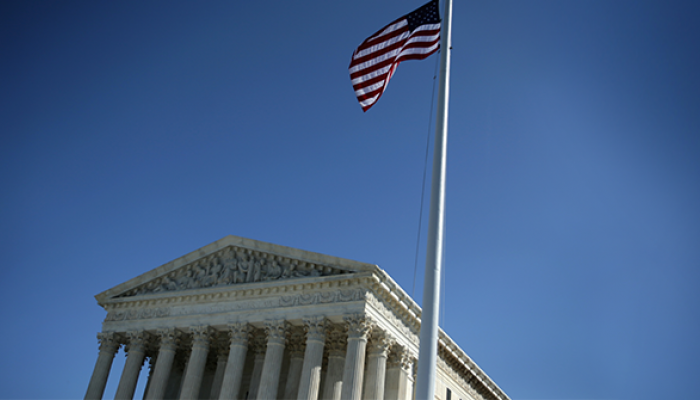The U.S. Supreme Court will once again tackle partisan gerrymandering this month when it hears arguments in cases challenging congressional maps in North Carolina and Maryland. These cases set the stage for the Court to finally put meaningful limits on the extreme gerrymandering that has plagued a handful of maps around the country this decade.
Help from the Court can’t come soon enough. This decade’s extreme gerrymanders have shown just how flagrantly politicians can abuse redistricting processes when they have the chance. And they are an omen of what could happen when election maps are redrawn in 2021 if the Court doesn’t step in now to set some limits on partisan mapmaking.
Here are answers to some common questions about the cases:
1. How are the North Carolina and Maryland cases similar?
The North Carolina and Maryland congressional maps at issue in these cases are among this decade’s starkest examples of extreme partisan gerrymanders, which lock in an artificial statewide majority for the political party drawing the maps, through good and bad election cycles.
The motives for these maps were extreme — and extremely clearly stated. In both of these cases, the politicians behind the gerrymanders made no secret of their plans to max out and lock in their party’s seats. Representative David Lewis, one of the lawmakers in charge of the North Carolina redistricting process, openly proclaimed that the map was a “political gerrymander” and that the Republicans’ goal was to “draw [it] to give a partisan advantage to ten Republicans and three Democrats.” Former Maryland Governor Martin O’Malley similarly testified that his goal was to “create a map that was more favorable for Democrats” by increasing their congressional seats from six to seven out of eight.
The results under these maps have been extreme, too. North Carolina’s map has created an artificial 10–3 Republican advantage in a state that is virtually evenly split in statewide races. The map has held even through the wave election of 2018 (pending a special election in the Ninth District). Meanwhile, in Maryland, Democrats have held a 7–1 advantage for the entire decade in a state that has recently elected Republicans to statewide offices and where alternative maps that offered better representation to African-American communities would have resulted in a 5–3 delegation.
2. How are these cases different from each other?
The North Carolina and Maryland cases differ from each other in several ways. The most important difference concerns their alternative legal theories for how the gerrymanders violate voters’ constitutional rights. The plaintiffs have put several different theories on the table for the Court.
One group of plaintiffs, which includes the League of Women Voters of North Carolina, contends that the North Carolina gerrymander violated Democratic voters’ rights under the First and Fourteenth Amendments because the mapmakers “diluted” their votes. In other words, the mapmakers drew the lines of multiple districts around the state to decrease the ability of Democratic voters to elect the candidates of their choice. According to this group of plaintiffs, vote dilution occurs when (1) mapmakers intentionally draw a district to undercut the voting power of voters from a rival party and (2) the map as a whole is systemically slanted to give one party an advantage in converting their votes into seats.
Another group of plaintiffs in the North Carolina case, which includes Common Cause, also argues that Democrats’ votes were diluted in districts around the state, but they have a different theory for proving it. According to this group, vote dilution occurs when (1) the mapmakers draw the lines of a district with the intention of undercutting the power of voters from a rival party who live there, and (2) those voters had their power meaningfully reduced.
This second group of plaintiffs, which also includes the North Carolina Democratic Party, makes two additional claims. First, they argue that the gerrymander undercuts Democrats’ associational rights under the First Amendment. In other words, the map makes it harder for Democrats to band together with other members of their party at the ballot box and get their candidates elected. And second, they contend that the gerrymander violates Article I of the U.S. Constitution, because it is a law that tries to dictate the outcomes of elections.
Meanwhile, the plaintiffs in Maryland argue that they are the victims of political retaliation that is forbidden under the First Amendment. They contend that the mapmakers specifically set out to flip Maryland’s Sixth District from red to blue in order to prevent GOP voters there from sending any more Republican candidates to Congress. The legislature accomplished this goal by removing large numbers of Republican voters from the Sixth District and replacing them with heavily Democratic precincts from the Washington, D.C. suburbs.
But the forest shouldn’t be lost through the trees: Many constitutional theories are in play in these cases, because the extremeness of the gerrymanders violates constitutional principles in many ways. In deciding the cases, the Supreme Court can choose the approach that best addresses the harm that is before it and minimizes the risk of unintended consequences.
3. How are these cases different from the ones that the Court heard last term?
Last term, the Supreme Court twice ducked opportunities to establish a rule against partisan gerrymandering, concluding that the Maryland case was premature and that the plaintiffs in the Wisconsin case hadn’t met the prerequisites for bringing suit. But it will be harder to avoid a major ruling with this term’s cases.
First, this term’s cases don’t face the kind of threshold legal problems that the Wisconsin case did. The Court rejected the Wisconsin appeal, concluding that the plaintiffs hadn’t shown evidence that they had suffered the kind of injuries that were necessary to get them into court —specifically, that their particular districts had been manipulated through cracking or packing of voters. The plaintiffs, who were all individual Democratic voters, only tried to show that Wisconsin’s state assembly map as a whole was slanted in favor of Republicans. That “standing” problem is gone now. Both the North Carolina and the Maryland cases have individual plaintiffs claiming that the specific districts where they live have been either packed or cracked.
Additionally, the Democratic Party is a party in the North Carolina cases. This opens up a new potential path to a win. Justice Elena Kagan suggested in her concurring opinion in the Wisconsin case that a statewide party might be able to win an “associational rights” claim under the First Amendment like the Common Cause plaintiffs are advancing now.
Other circumstances have also changed. For starters, the Supreme Court has a new face, with Justice Anthony Kennedy retiring and Justice Brett Kavanaugh replacing him. Justice Kennedy was long considered a key swing vote on partisan gerrymandering, while Justice Kavanaugh’s views are uncertain. Some have suggested that Justice Kennedy’s retirement will make it hard to win partisan gerrymandering cases, but that view is too pessimistic. Indeed, during last year’s oral arguments, both Chief Justice John Roberts and Justice Samuel Alito expressed serious concerns with the legality of maps openly designed to disadvantage one party. That is exactly the fact pattern they are confronting in the North Carolina and Maryland cases.
There is also increased urgency for a rule against partisan gerrymandering with the next round of redistricting rapidly approaching. During the last term, the Court may have believed that it had more time to figure things out, but that time is now running dangerously short. The increased urgency of the situation, combined with the stark facts of gerrymandering in North Carolina and Maryland, could help the Justices get to an agreement to put an anti-gerrymandering rule in place.
4. What are defenders of these gerrymanders telling the Court?
The attorneys for North Carolina and Maryland have raised a battery of arguments to convince the Supreme Court to overturn the plaintiffs’ victories in the lower courts. Paul Clement, the attorney for North Carolina, argues that the Constitution offers no “judicially manageable standard”—that is, clear legal principles to focus the courts’ attention when they hear partisan gerrymandering claims. The greatest evidence of the lack of a standard, Clement contends, is the sheer number of constitutional theories at play in these cases.
Many of the other arguments on the table are familiar from past cases before the Court. Some of these arguments look backward. For instance, the maps’ defenders contend that the long history of partisan gerrymandering in America suggests that the practice cannot possibly be unconstitutional. Friend-of-the-court briefs supporting the maps’ defenders also argue that courts historically have been bad at identifying when a map has entrenched one party in power.
Other arguments look forward, raising concerns about the consequences of ruling for the plaintiffs. Most significantly, the maps’ defenders have argued that a ruling for any of the plaintiffs will open the floodgates for an overwhelming tide of partisan gerrymandering cases in upcoming years.
Strong counterarguments exist for each of these contentions. But plaintiffs will nonetheless have to address them when they appear before the Justices later this month.
5. How would rulings in these cases affect voters?
A ruling for either the North Carolina or Maryland plaintiffs could set some important outer limits on the most extreme cases of partisan map manipulation. This would help ensure that politicians can’t rig maps to maximize their seats, cement their advantage, or minimize their opponents’ voices. Such a ruling wouldn’t suddenly allow voters to challenge maps all around the country. But voters in the small number of states where there are still similar extreme gerrymanders, like Ohio and Michigan, could see some last-minute relief.
Even a limited ruling like this would send a powerful signal to the legislatures that will redraw the maps in 2021, making it clear that the partisan shenanigans of this decade will not be tolerated in the next. That could limit the number of extreme cases that the Court will have to take up in the 2020s.
(Image: Alex Wong/Getty)

